Edmund Henry Osthaus stands as a significant figure in American art history, particularly renowned for his masterful depictions of sporting dogs. Born in Germany but spending his most productive years in the United States, Osthaus captured the spirit, anatomy, and movement of canines with unparalleled skill and sensitivity. His work not only appealed to sportsmen and dog lovers but also earned him a lasting place among America's finest animal painters. His life journey, from the esteemed art academies of Europe to the fields and studios of the American Midwest and South, shaped a unique artistic vision centered on the natural world and its inhabitants.
Early Life and Artistic Formation in Germany
Edmund Henry Osthaus was born on August 5, 1858, in Hildesheim, Germany. He was the son of privilege, his father being a prosperous farmer. This background likely afforded him opportunities for education and travel that nurtured his early artistic inclinations. Recognizing his talent, his family supported his pursuit of formal art training, a decision that would lay the foundation for his entire career.
His artistic education took place at the prestigious Royal Academy of Arts in Düsseldorf. This institution was a major center for art education in Europe, known for the Düsseldorf School of painting, which emphasized detailed and often sentimental or narrative genre and landscape painting. During his time there, Osthaus studied under several accomplished artists who shaped his technical skills and artistic perspective.
Among his notable instructors were Andreas Müller, known for his historical and religious subjects, and Eduard von Gebhardt, a major figure associated with the Düsseldorf School, celebrated for his historical and religious paintings rendered with realism. He also received guidance from Ernst Deger, another artist associated with the Nazarene movement and religious art, and Christian Kröner, who specialized in landscape and animal painting, particularly hunting scenes. This diverse tutelage exposed Osthaus to various styles and subjects, from meticulous realism to the dynamic portrayal of animals in nature.
Emigration and a New Beginning in America
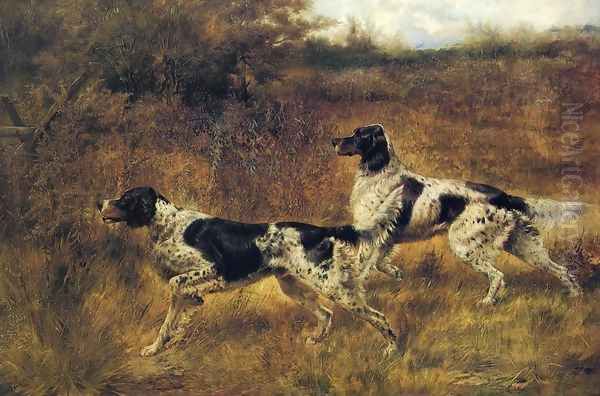
In 1883, seeking new opportunities, Edmund Osthaus emigrated with his family to the United States. They settled in Toledo, Ohio, a growing city that would become the center of his artistic activities for many years. The move marked a significant transition, transplanting his European training into an American context where themes of wildlife, sport, and the outdoors held particular appeal.
Shortly after arriving, Osthaus, alongside his sister Mary, initially engaged in the local art scene, possibly running a small gallery. His skills were quickly recognized, and he secured a position at the Toledo Academy of Fine Arts. He rose to become the principal instructor at the academy, sharing his knowledge and European training with American students. His teaching focused on subjects he was passionate about: animal painting and landscape painting.
His role as an educator was significant in the developing art community of Toledo. However, the demands of teaching eventually conflicted with his desire to dedicate himself fully to his own creative work. The American landscape and its sporting traditions offered fertile ground for the subjects he most loved to paint.
Transition to Full-Time Artist
Around 1893 (though some sources suggest slightly later), Osthaus made the pivotal decision to leave his teaching position at the Toledo Academy of Fine Arts. This move allowed him to devote his entire energy to his burgeoning career as a professional painter. He established his own studio in Toledo, which became his base of operations for creating the works that would solidify his reputation.
This period marked the true beginning of his focus on the subjects for which he is best known. Free from academic duties, he could fully immerse himself in observing and painting animals, particularly the sporting dogs that fascinated him. He also continued to explore landscape painting, often incorporating detailed natural settings as backdrops for his animal subjects. His studio became a space where his European training met his American experiences and passions.
In 1892, Osthaus married Charlotte Becker. Family life became part of his American experience, grounding him further in his adopted country. His growing success as an independent artist affirmed his decision to leave academia and pursue his unique artistic path.
The Heart of His Art: Sporting Dogs and Wildlife
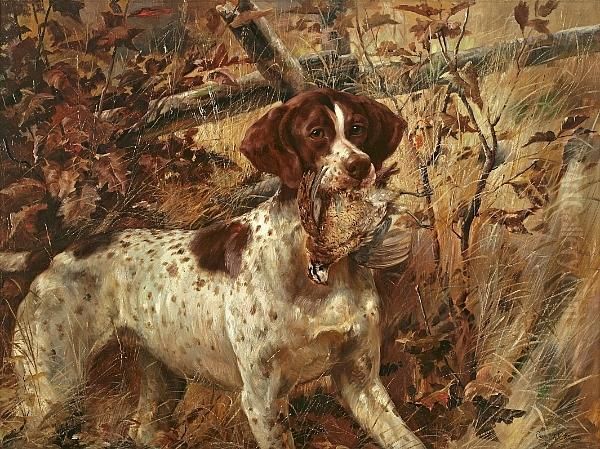
Edmund Henry Osthaus is overwhelmingly celebrated for his paintings of sporting dogs, particularly pointers and setters. He possessed an extraordinary ability to capture not just the physical likeness of these animals but also their individual personalities, energy, and instinctive behaviors. His canvases often depict dogs in action – pointing game birds, retrieving, or simply exhibiting the alertness and grace characteristic of their breeds.
His deep understanding of canine anatomy was evident in the accuracy and dynamism of his portrayals. He didn't merely paint generic representations; each dog feels like an individual portrait, imbued with life and character. This sensitivity likely stemmed from his own connection to dogs and the sporting life. He was himself an avid sportsman, knowledgeable about hunting and the roles these dogs played.
While dogs were his primary focus, Osthaus also painted other animals, including horses and cattle, as well as pure landscapes and wildlife scenes. His landscapes often depicted the fields, marshes, and woodlands frequented by hunters and their dogs, rendered with the same attention to detail and atmosphere found in his animal portraits. His commitment to realism ensured that both the animals and their environments were depicted with authenticity.
Artistic Style and Technique
Osthaus's artistic style was firmly rooted in Realism and Naturalism, traditions emphasized during his training in Düsseldorf. He excelled at meticulous detail, accurately rendering the texture of fur, the intensity in a dog's eyes, or the specific foliage of a landscape. His works demonstrate a keen observational skill, capturing subtle nuances of light, shadow, and atmosphere that bring his scenes to life.
He was proficient in various artistic media, adapting his technique to suit the subject and desired effect. While best known for his oil paintings, he also worked extensively in watercolor, a medium that allowed for lighter, more fluid depictions, particularly suitable for landscapes or preliminary sketches. Furthermore, Osthaus created works using pen and ink, as well as pencil, showcasing his foundational drawing skills.
His technical versatility extended to printmaking. He produced etchings and lithographs, often based on his paintings. This allowed his work to reach a broader audience beyond the collectors of original canvases. His prints, particularly those featuring champion dogs, were popular among sporting enthusiasts. A contemporary description aptly noted that his subjects seemed "livingly transferred from field to canvas," highlighting the vibrant realism that defined his unique style.
A Passion for the Outdoors: The Sportsman-Artist
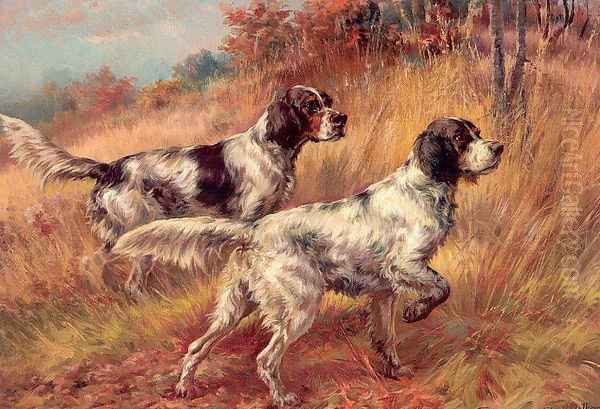
Osthaus's art was deeply intertwined with his personal life and passions. He was not merely an observer of the sporting world; he was an active participant. An accomplished sportsman, he enjoyed hunting and fishing, activities that provided him with firsthand knowledge of the animals and environments he depicted. This intimate familiarity infused his work with an authenticity that resonated with fellow enthusiasts.
His passion for field sports extended beyond personal enjoyment. He played a key role in the sporting community, notably as a co-founder of the National Field Trial Association. This organization was dedicated to promoting and judging the skills of hunting dogs. In its early years, Osthaus contributed his artistic talents by painting portraits of the champion dogs from the association's competitions, further cementing his connection between art and sport.
Later in life, his love for the outdoors led him to build a hunting lodge near Marianna, Florida. This retreat allowed him to spend considerable time in nature, hunting, fishing, and undoubtedly finding inspiration for his art. His life exemplified the archetype of the sportsman-artist, where personal experience directly informed and enriched creative expression.
Commercial Success and Wider Recognition
Beyond the realm of fine art galleries, Osthaus achieved significant commercial success and broad recognition, partly through strategic commissions and illustrations. One of his most notable commercial collaborations was with the DuPont Powder Company. Around 1901, DuPont commissioned him to create a series of "Champion Portraits," depicting celebrated field trial dogs.
These paintings were widely reproduced by DuPont for advertising purposes, appearing on promotional materials such as calendars, postcards, lithographs, and etchings. A particularly famous series documented "All Champion Field Trial Dogs from 1846 to 1900." This partnership significantly increased Osthaus's visibility, bringing his art into the homes and businesses of countless Americans, especially those interested in hunting and firearms.
Osthaus also contributed illustrations to prominent outdoor and sporting magazines of the era, such as The American Field, Forest and Stream, and likely Field and Stream . His etchings and drawings for these publications further disseminated his work among his target audience. His original paintings commanded high prices, with works like Pointer & Quail fetching ,000 and On Point selling for ,400 at auction in later years, demonstrating their enduring value in the art market.
Representative Masterpieces
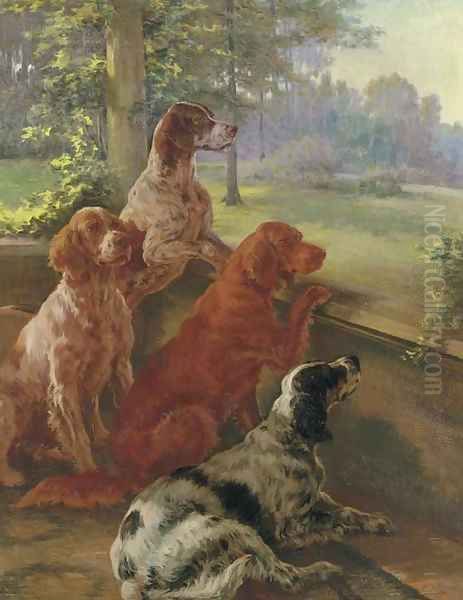
Several works stand out as representative of Edmund Henry Osthaus's skill and thematic focus. Hunting Dogs often depicts multiple dogs, perhaps setters or pointers, waiting with anticipation or interacting in a natural setting, showcasing his ability to handle complex compositions and canine group dynamics. These works capture the readiness and inherent instincts of the breeds.
Pointer & Quail is a classic Osthaus theme, typically showing a pointer locked in its characteristic stance, indicating the presence of hidden quail. These paintings highlight the dramatic tension of the hunt and the dog's intense focus, set against a meticulously rendered landscape. The high auction price achieved by a work with this title underscores its desirability among collectors.
Similarly, On Point captures that quintessential moment when a sporting dog freezes to signal game. Osthaus masterfully conveys the dog's rigid posture, unwavering gaze, and the palpable energy of the scene. These works are prime examples of his ability to blend anatomical accuracy with the narrative drama of the hunt.
Waiting for Master explores the theme of canine loyalty and patience. Often depicting several dogs, perhaps near hunting gear or a doorway, this subject allowed Osthaus to explore the emotional connection between dogs and their human companions, showcasing different breeds and their individual expressions while waiting.
A work titled Hunting in an Upland Landscape represents his larger compositions, integrating hunters, dogs, and expansive natural scenery. Such paintings demonstrate his skill not only in animal portraiture but also in landscape painting, capturing the specific atmosphere and terrain of American hunting grounds. These pieces offer a complete vision of the sporting life he knew so well.
Civic Engagement and Later Years
Beyond his studio practice, Edmund Henry Osthaus was actively involved in the cultural life of his community, particularly in Toledo. He was a co-founder of the Tile Club, an informal group likely dedicated to artistic camaraderie and perhaps decorative arts, reflecting a common type of artists' association during that period.
More significantly, Osthaus played a role in the establishment of the Toledo Museum of Art. His involvement as one of the founders underscores his commitment to fostering arts and culture in his adopted city. His participation connected him with other civic leaders and patrons, integrating him into the fabric of the community beyond his identity as an animal painter.
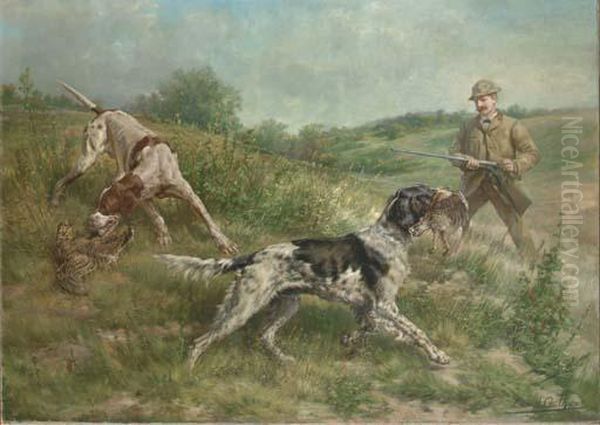
In 1911, seeking new horizons or perhaps warmer climes for part of the year, Osthaus expanded his presence by opening a gallery and studio in Los Angeles, located in the Walker Theatre Building. This move suggests a desire to reach new markets and audiences on the West Coast. However, his connection to the Midwest and eventually the South remained strong. He spent his later years enjoying his hunting lodge in Marianna, Florida, continuing to paint and pursue his love for the outdoors until his death there on January 30, 1928.
Artistic Context and Connections
Edmund Henry Osthaus's artistic journey began under the influence of the Düsseldorf Academy and his specific teachers there: Andreas Müller, Eduard von Gebhardt, Ernst Deger, and Christian Kröner. This training provided a strong foundation in academic realism and technique. While the provided sources indicate no direct collaborations with other painters later in his career, his work exists within broader artistic contexts.
The tradition of animal painting, or "animalier" art, was well-established in Europe. Artists like Sir Edwin Landseer in Britain, famous for his dramatic paintings of dogs and stags, and Rosa Bonheur in France, renowned for her realistic depictions of farm animals and wildlife, were prominent figures whose work shared thematic ground with Osthaus's, even if direct influence isn't documented in the source material. They represent the high regard for animal subjects in 19th-century art.
In America, Osthaus worked during a period when landscape and scenes of American life were gaining prominence. While distinct in his focus, his work shares an interest in the natural world with landscape painters like Winslow Homer, who also depicted hunting and outdoor scenes. Contemporaries like Arthur Fitzwilliam Tait were known for sporting and wildlife subjects, while illustrators like A.B. Frost captured sporting life with humor and accuracy. Artists of the American West, such as Frederic Remington, also frequently depicted animals, particularly horses, with great dynamism. Osthaus carved his niche within this broad interest in the American outdoors, specializing in the intimate portrayal of sporting dogs.
Legacy and Influence
Edmund Henry Osthaus left an indelible mark on American art, particularly within the genre of sporting and animal painting. He is widely regarded as one of the foremost, if not the premier, painter of sporting dogs in American history. His ability to combine technical precision with genuine empathy for his subjects set his work apart. He didn't just paint animals; he captured their essence.
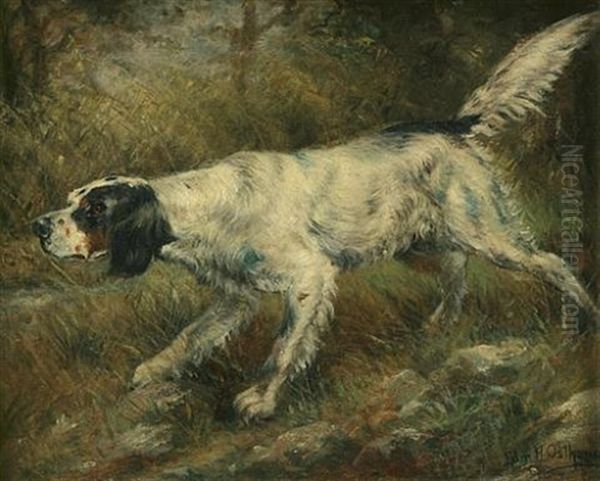
His influence extends through his contributions to the sporting art genre, setting a high standard for realism and anatomical accuracy that inspired subsequent artists in the field. His work helped elevate the depiction of dogs from mere accessories in hunting scenes to central subjects worthy of serious artistic attention. The enduring popularity of his paintings and prints, and their continued high value at auction, attests to his lasting appeal to collectors and enthusiasts.
Furthermore, his involvement in founding cultural institutions like the Toledo Museum of Art and his work for national publications and companies like DuPont demonstrate a broader impact beyond the canvas. Edmund Henry Osthaus remains a celebrated figure, remembered for his dedication to his craft, his passion for the outdoors, and his unparalleled ability to bring man's best friend to life in art.